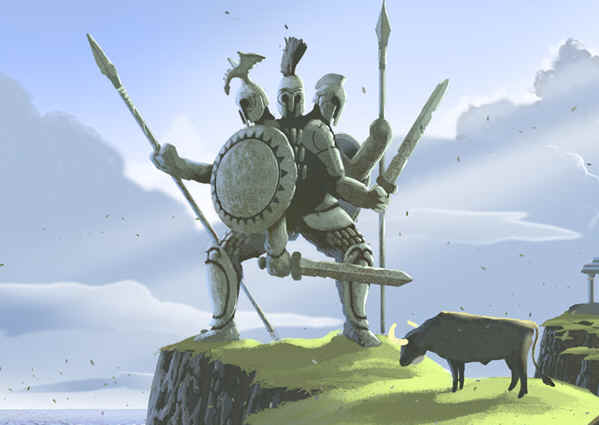In Greek mythology, Geryon (Geryones, Geyron), son of Chrysaor and Callirrhoe and grandson of Medusa was a fearsome giant who dwelt on the island Erytheia of the mythic Hesperides in the far west of the Mediterranean. A more literal-minded later generation of Greeks associated the region with Tartessos in southern Iberia. Geryon was often described as a monster with human faces. Geryon had three heads and three bodies with a total of six arms. Some accounts state that he had six legs as well while others state that the three bodies were joined to one pair of legs. Although there are some mid-sixth century Chalcidian vases portraying Geryon as winged, it is not known whether

Stesichorus’ Geryon had wings: it seems unlikely. Apart from these
weird features, his appearance was that of a warrior. He owned a two-headed
hound named Orthrus, which was the brother of Cerberus, and a herd of
magnificent red cattle that were guarded by Orthrus, and a herder Eurytion, son
of Erytheia.
In the fullest account in the Bibliotheke of
Pseudo-Apollodorus
Hercules was required to travel to Erytheia, in order to obtain the Cattle of
Geryon as his tenth labor. On the way there, he crossed the Libyan Desert and
became so frustrated at the heat that he shot an arrow at Helios, the Sun.
Helios “in admiration of his courage” gave Hercules the golden cup he used
to sail across the sea from west to east each night. Hercules used it to reach
Erytheia, a favorite motif of the vase-painters. Such a magical conveyance
undercuts any literal geography for Erytheia, the “red island” of the
sunset.
When Hercules reached
Erytheia, no sooner had he landed
than he was confronted by the two-headed dog, Orthrus. With one huge blow from
his olivewood club, Hercules killed the watchdog. Eurytion the herdsman came to
assist Orthrus, but Hercules dealt with him the same way.
On hearing the commotion, Geryon sprang into action,
carrying three shields, three spears, and wearing three helmets. He pursued
Hercules at the River Anthemus but fell a victim to an arrow that had been
dipped in the venomous blood of the Lernaean Hydra, shot so forcefully by
Hercules that it pierced Geryon’s forehead, “and Geryon bent his neck over
to one side, like a poppy that spoils its delicate shapes, shedding its petals
all at once” With a shrill, despairing groan, Geryon swayed, then fell,
nevermore to rise. In some versions, Hercules tore Geryon’s bodies into three
separate pieces.
Hercules then had to herd the cattle back to
Eurystheus.
In Roman versions of the narrative, on the Aventine hill in Italy, Cacus stole
some of the cattle as Hercules slept, making the cattle walk backwards so that
they left no trail, a repetition of the trick of the young Hermes. According to
some versions, Hercules drove his remaining cattle past a cave, where Cacus had
hidden the stolen animals, and they began calling out to each other. In others,
Caca, Cacus’ sister, told Hercules where he was. Hercules then killed Cacus,
and according to the Romans, founded an altar where the Forum Boarium, the
cattle market, was later held.
To annoy Hercules, Hera sent a gadfly to bite the
cattle, irritate them and scatter them. The hero was within a year able to
retrieve them. Hera then sent a flood that raised the level of a river so much
that Hercules could not cross with the cattle. He piled stones into the river to
make the water shallower. When he finally reached the court of Eurystheus, the
cattle were sacrificed to Hera.